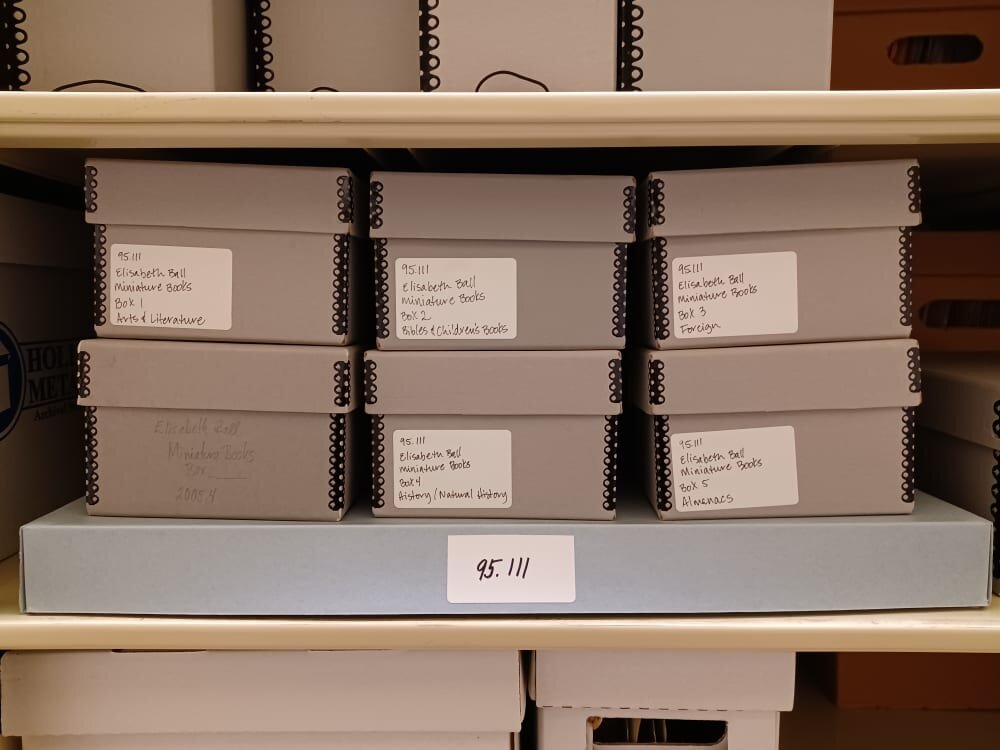Small Books, Big Story
A couple of months ago while playing with one of my nieces, she boldly declared, “These toys are so cute, because they are so small!” When I questioned if the toys really were cute just because they were small, she hit me with all of her eight-year-old confidence. “Yes, Auntie Jess. EVERYTHING is cuter and cooler when it’s small.” Fast forward a couple of months to when I was pulling an item from our archives here at Minnetrista. While grabbing a specific box, I glanced to the side and caught a glimpse of our stack of boxes labeled, “Miniature Books.” As soon as I saw the words a big smile came across my face. For the moment, I continued on with the task at hand. But when the time came to return the items to their shelf, I took a moment to open “Miniature Books Box 1.”
View of archival boxes in Minnetrista’s environmentally controlled archival storage area.
In the 1930s, George Ball purchased two major caches of rare children’s books. This detail from a 1932 receipt shows just a few of the titles he bought to add to his private collection.
Minnetrista Heritage Collection
While I have explored and examined the contents of our “Miniature Books” storage boxes many times, this time around I had my niece’s words in my ears – “EVERYTHING is cuter and cooler when it’s small.” And you know what? Maybe my niece has a point. Some things are cooler when they are tiny. And in hindsight, maybe George and Betty Ball shared my niece’s viewed on the topic.
As a young man, George Ball became interested in the childhood books that later impacted successful individuals. Whenever he could, he would inquire, “What book influenced you as a child?” He would then note the title and seek out a copy of the book to read. Over time one thing led to another, and this exercise became a lifelong passion for collecting rare children’s books. A passion he would later share with his daughter Betty. In fact, over several years George and Betty amassed what would become the world’s largest collection of privately held rare children’s books. Amongst their 10,000 volumes – which included works of literature, instructional and educational books, and everything in between – was a grouping of volumes set apart by their diminutive size.
Cover of the June 1958 issue of Hobbies magazine. The cover features images of miniature books owned by George and Betty Ball.
Minnetrista Heritage Collection
Writing in the June 1958 issue of Hobbies magazine, Betty Ball said, “Grown-ups, even more than children, are intrigued by the miniature, and book collectors are no exception. So it was not strange that my father, George Ball … always interested in the unusual and in perfection, should have gathered miniature books.” But, what exactly qualifies a book as “miniature”? At the time George and Betty were collecting in the 1920s, ‘30s, and ‘40s, collectors defined miniature book as nothing taller than 2 ½ inches. First appearing in the 16th century and exploding in popularity in the 19th century, publishers produced physically tiny books for a variety of reasons. Some – including travel guides – were meant to ease the burden of carrying larger, clunky volumes when traveling. Others that dealt with more taboo topics could easily be kept discreet by the reader due to the small dimensions. And many were simply produced as spectacle. As my niece would say, “They’re cool because they are small.”
Miniature books collected by George and Betty Ball. Note the dime for scale!
Minnetrista Heritage Collection
Betty and George Ball, around 1900.
Minnetrista Heritage Collection
Browsing the Ball’s miniature books in the Minnetrista Heritage Collection, genres range from Bibles to Almanacs, and works of fiction to volumes on natural history and botany. It would seem that George and Betty were not particular about the topics they collected, but instead more interested in the craftsmanship, the whimsy, the history of the volumes, and the act of collecting itself. When asked how she became interested in collecting books, Betty indicated that she could not pinpoint an exact moment or event that grabbed her attention. Instead she explained to Hobbies magazine that, “we were a family who did things together.” While father and daughter both loved books, even more so they loved sharing a unique experience. Collecting books provided opportunities for them to create shared memories. It allowed them to work together towards a shared goal – enjoying the thrill of the hunt along the way! And miniature books captured the imaginations of both George and Betty at the same time. Something that George likely loved experiencing with Betty when she was a child, and then had the joy of continuing when both were adults.
If you’d like to learn more about George and Betty’s love of books, I’d encourage you to visit the Oakhurst Experience on Minnetrista’s campus. Through a variety of hands-on interactives, visitors can dive into the big story of George and Betty’s book collection while creating shared memories of their own. And if you are interested in doing research or would like to see some of George and Betty’s miniature books up close, we welcome you to make an appointment to visit our research library - https://www.minnetrista.net/heritage-collection. The Minnetrista Heritage Collection is open to the public for research, and our Collections and Storytelling team are ready to assist you in discovering the history and stories of the Ball family, Ball Company, and East Central Indiana.




